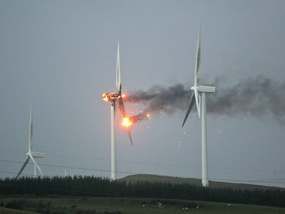Does this picture spell doom for wind power?
By Geraint Jones, www.express.co.uk 11 December 2011
The wrong kind of wind? It’s a phrase that haunts those desperately trying to justify wind farms in Britain. However, apologists for the giant turbines now face the unpalatable truth that structures designed to operate in windy conditions literally fell flat on their faces when the wind became a bit too strong.
As storms battered Scotland on Thursday a 300ft turbine exploded like a giant Catherine wheel, showering the countryside with burning debris.

This wind turbine fire is a setback for the green power plans of Chris Huhne
Witnesses said fire erupted in the centre of the £2million turbine in Ardrossan, North Ayrshire, then flames covered the blades.
The day before, a turbine at Coldingham in the Scottish Borders was brought crashing down by the wind. Several homes had to be evacuated and a road closed. On Tuesday a turbine put up earlier this year fell in high winds at Scapegoat Hill near Huddersfield .
The three incidents added to concerns about the policy of covering some of Britain’s most spectacular land with turbines in the name of green energy and cutting carbon emissions.
The Country Guardian organisation warned: “There is a general trend upward in accident numbers over the past 10 years. This is predicted to escalate unless the Health and Safety Executive makes some significant changes, in particular to protect the public by declaring a minimum safe distance between new turbine developments and occupied housing and buildings (currently 2km in Europe), and declaring ‘no-go’ areas to the public.”
It said structural failure was the third most common cause of turbine accidents with 58 instances recorded between 1999 and 2008.
Turbine problems are not unknown. On Christmas Eve 2005 a wind turbine at Nissan car plant in Sunderland burst into flames. Now turbines usually have a safety mechanism that stops the blades if wind speeds reach 56mph but this means when the wind is at its most potent, no electricity is produced.
In Scotland’s storm on Thursday the equivalent of the supply to a million homes was lost because turbines halted. Martin Livermore, director of the Scientific Alliance, said: “ These wind turbines cannot generate electricity when the wind is too strong so a lot of the time they are not actually saving any fossil fuels.”
We will see a big rise in the number of turbines but they cannot generate enough energy to reduce global carbon dioxide levels by a meaningful degree and need back-up coal and gas power plants which dents the saving of greenhouse gas emissions.
According to the latest figures, the 280ft generator overlooking the M4 near Reading, Berkshire, worked at 15 per cent of its capacity last year. It generated electricity worth an estimated £100,000 but had to be subsidised with £130,000 of public money. Since it was switched on in 2005, it has had £600,000 in public subsidies while working at an average of 17 per cent of its capacity.
Britain has 3,421 turbines, 2,941 of them onshore . An analysis of official figures suggests up to 32,000 could be built in the next 20 years, at least 6,000 of them onshore. Energy Secretary Chris Huhne says they are needed to meet Britain’s energy targets. A carbon plan published by the Department of Energy and Climate Change outlines a tenfold expansion in use of renewable energy, mostly wind, in the next 40 years.
Electricity customers pay an average of £90 a year to subsidise wind farms and other forms of renewable energy as part of a government scheme to meet carbon-reduction targets. Two-thirds of our wind turbines are owned by foreign companies, which are estimated to reap £500million a year in subsidies.
Dr John Constable, of the Renewable Energy Foundation, said levies for these measures were falling disproportionately on poorer households, adding: “By 2020, the subsidies for renewable electricity will be adding £8billion a year to consumer bills. ”
Fraser McLachlan, chief executive of GCube, a wind turbine insurer, said he was expecting a rise in turbine failures due to the “exceptional” weather in Scotland. Trade body RenewableUK called for calm in the wake of the turbine fire and said “incidents of this nature are extremely rare”.
A spokesman for renewable energy company Infinis, which owns the Ardrossan wind farm, said the site had been disconnected from the National Grid as a precaution.
The worst of the brutal weather which hit northern Britain last week has passed but a storm that might blow away the Government’s wind energy ambitions is gathering force.
URL to article: https://www.wind-watch.org/news/2011/12/11/does-this-picture-spell-doom-for-wind-power/